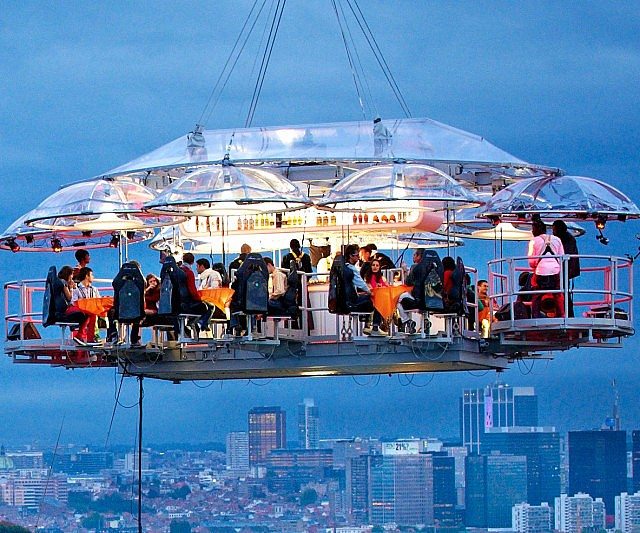Afraid of heights…this may not be your cup of tea
Mixing construction equipment with gourmet cooking, two Belgian entrepreneurs are trying to elevate haute cuisine. Their effort began here as a stunt six years ago, when publicist David Ghysels and crane specialist Stefan Kerkhofs seated 22 people around a chef and hoisted everybody 180 feet into the air for a meal. Today, the Dinner in the Sky franchise has tables dangling in more than 40 countries, serving about 1,000 people each month.
Dinner in the Sky
“It’s just a table hanging from a rope,” says Mr. Ghysels, who has been surprised at the entertainment possibilities of extremely conspicuous consumption.
Now, having demonstrated that certain people around the world will fork over up to $500 apiece to dine strapped in like babies in car seats, the Belgian duo are trying to outdo themselves with acrobatic catering. Their latest brainstorm: cocktails served by tightrope walkers.
But finding spin-offs that fly can be tricky. Marriage in the Sky “seemed great on paper” but flopped with Europeans, who balked at spending $15,000 for 20 guests, says Mr. Ghysels. He hopes the concept will take off with adventurous Americans or perhaps in India, where it could serve as one element of lavish, extended wedding ceremonies.
Some meals can become nail-biters. When the team dangled a musical duo to serenade a nearby table of elevated diners, the piano player got scared that his bench would slip off the airborne stage, recalls Mr. Ghysels. But he calmed down.
Dinner is Served—And Hanging From a Rope
See photos from some Dinner in the Sky events:
Diners who have experienced Dinner in the Sky events say it works best in locations with great views.
Even a Michelin two-star chef couldn’t tempt some acrophobic invitees to an exclusive lunch overlooking the Belgian royal palace last summer. Organizer Pascale Dedonker, who is country manager for Switzerland Cheese Marketing, says the promotional event was actually no more disconcerting than a ski lift.
Joy Sinberg insisted that crane operators take her up before she would approve the attraction for guests at a casino complex in Coconut Creek, Fla. She also pressed the team to get a $10 million insurance policy.
“It wasn’t really as dangerous as it sounds,” says Ms. Sinberg, who manages risk and insurance for the Seminole Tribe of Florida, owners of the Hard Rock Cafe chain. “It’s like a big elevator.” A giant fire-spitting dinosaur spectacle at another of the tribe’s casinos “was a lot scarier” she says.
Most guests quickly get in the mood, experienced diners say. Wine promoter Baudouin Havaux staged Cabernet tastings at a table hanging over the Formula One racetrack of the Belgian Grand Prix in 2007 to gin up publicity. The opportunity made jaded adults “as excited as children at Disneyland,” he says.
Some people get too comfortable. Mr. Ghysels recalls “a very famous woman” who was irked by the shoulder straps and kept trying to remove them. After repeated requests to stop, he says, she was asked to leave the table. It descended first.
As with expensive restaurants, location is critical. Dinner in the Sky has run meals with breathtaking views of Rome, São Paulo and Sydney, which help if the novelty of elevation wears off.
“I’ve never heard anyone say, I’d really like to dangle from a crane and be fed,” says Scott Kennedy, co-owner of Candyfish, a sushi restaurant in Delray Beach that did catering for the Seminole casino.
“It’s a cool experience,” he says. But “Delray Beach is not the prettiest city. And at night you can’t see the ocean because it’s pitch black.” His ideal location is Las Vegas.
The owners of Victoria’s Wedding Chapel in Las Vegas agree, which is why they are opening a permanent installation under franchise in a few weeks. “It totally fits Las Vegas,” says spokeswoman Jennie Hendricks.
In the city of nonstop glitz, nobody questioned the idea of two tables going up and down, offering eight “flights” a night, she says. Other questions did arise.
“A lot of people ask how do you go to the bathroom,” Ms. Hendricks says. The trip requires lowering the whole table, which takes about three minutes. “We strongly encourage people to go beforehand,” she says.
And an area on the ground below the table is kept clear in case a diner drops a fork.
Handling such down-to-earth concerns was one of the challenges when the Belgian creators got started. Mr. Ghysels, who is 48 and owns a creative marketing agency called Hakuna Matata, around 2004 wanted to celebrate his daughter’s birthday in the air but lacked lift.
Mr. Kerkhofs, 43, separately hit on the idea of suspending a table. He had grown up playing around heavy equipment at his parents’ construction firm and in 1990 started his own bungee-jump company. “I know what you can do with a crane,” he says.
When an acquaintance connected them in 2006, “it was like telepathy,” says Mr. Kerkhofs, who also owns an event company called the Fun Group.
An early focus was on making the equipment safe and on assuring diners that they wouldn’t slip off. Tables and seats have redundant attachments and an extra person is on hand at each meal to enforce strict procedures. The owners say they realize that an accident could doom their business. “It’s entertainment,” says Mr. Ghysels. “It’s not something necessary.”
After the first meal, in April 2007, drew attention, requests to replicate it arrived from the U.S. and Germany, so the duo began franchising. The tables’ visibility meant they could be turned into floating billboards and thus attract sponsors to offset the high cost of an event.
Expanding into Saudi Arabia posed a problem because of rules against men and women mixing socially. So rather than offering a single table, the company developed a cluster of six four-person tables served by tethered wait staff. The arrangement is now being offered as Lounge in the Sky. Two tables can be removed to make room for musicians or dancers, who perform in tethers similar to parachute harnesses.
While Dinner in the Sky keeps trying new gimmicks—like wrapping a table in rough wood to resemble a beach bar, with palm tree roots dangling—the company has no plans to expand in other directions, like undersea dining. “Water is great, but you need sponsors,” says Mr. Ghysels. “Under water, nobody looks at you except fish.”
|



There are no comments yet